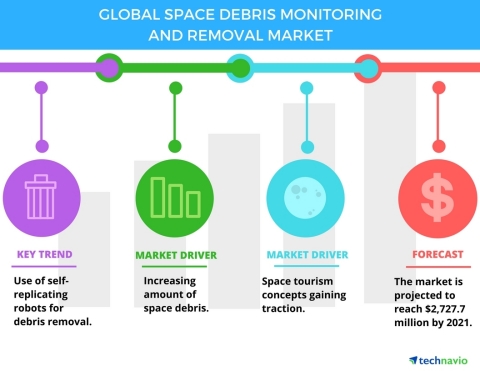LONDON--(BUSINESS WIRE)--Technavio analysts forecast the global space debris monitoring and removal market to grow at a CAGR of over 4% during the forecast period, according to their latest report.
The research study covers the present scenario and growth prospects of the global space debris monitoring and removal market for 2017-2021. Technavio presents a detailed picture of the market by way of study, synthesis, and summation of data from multiple sources.
In 2015, an Italian start-up came up with a proposal, termed as D-Orbit. It suggested the installation of a decommissioning device before the launch of new spacecraft, which can be remotely activated at the end of the satellite's lifecycle. This would also trigger the expulsion of the defunct satellite out of its orbit in a safe and controlled way and eliminate the need to develop a whole new product for debris removal.
This report is available at a USD 1,000 discount for a limited time only: View market snapshot before purchasing
Buy 1 Technavio report and get the second for 50% off. Buy 2 Technavio reports and get the third for free.
Technavio analysts highlight the following three factors that are contributing to the growth of the global space debris monitoring and removal market:
- Space tourism concepts gaining traction
- Ground-based radars to assess collisional threats for spacecraft
- Advances in spatial environment concepts
Looking for more information on this market? Request a free sample report
Technavio’s sample reports are free of charge and contain multiple sections of the report including the market size and forecast, drivers, challenges, trends, and more.
Space tourism concepts gaining traction
With the advances in technology and chain of successful launches, a new segment of tourism, Space Tourism, is gaining traction. It is a safe venture into space for a limited duration that highlights the view of the Earth from outer space and imparts the experience of weightlessness of space, zero gravity effect, etc. Space tourism, though a far-fetched concept for masses, can be expected to attract tourists with financial viability soon.
Space vehicles, such as the ones developed and operated by Blue Origin and Virgin Galactic, can pave the way to this concept. Virgin Galactic has sold around 640 seats, and the experience lasted for around 4-5 minutes, costing around USD 250,000 for a single ticket. SpaceX is developing a new space tourism vehicle, called Dragon V2 spacecraft, capable of carrying two tourists on a trip to space.
Ground-based radars to assess collisional threats for spacecraft
Researchers often find it challenging to find a defunct spacecraft and space debris in Earth's orbit and around the Earth's moon. Also, optical telescopes are often incapable of searching small objects in the bright light of the moon. To address this challenge, scientists from NASA's Jet Propulsion Laboratory in Pasadena, California, developed an interplanetary radar that can locate two spacecrafts, one active and one run-down, orbiting the moon.
Avimanyu Basu, a lead space research analyst at Technavio, says, “The researchers employed a NASA's 230-foot antenna at NASA's Goldstone Deep Space Communications Complex in California to detect spacecraft 237,000 miles away by deploying a powerful beam of microwaves toward the moon. As a result, the radar echoes reflected from the lunar orbit and were received by a 330-foot Green Bank Telescope in West Virginia.”
Advances in spatial environment concepts
NASA has partnered with six organizations to build full-scale prototypes and concepts of human space habitats, with an investment of USD 65 million initially and more investments planned for future. The habitats are either orbital, space, or deep space based, and are not meant to be used on a surface of a planet or a moon. NASA has partnered with companies that are expected to bear 30% of the cost.
“With gradual evolution of technologies contributing to the survival of living organisms in space, it can be expected that the challenge of increasing number of space debris will attract further investment and instrument several research initiatives,” adds Avimanyu.
Top vendors:
- Airbus
- ASTROSCALE
- Boeing
- Lockheed Martin
- RSC Energia
Browse Related Reports:
- Global Military Satellite Market 2017-2021
- Global Remote Sensing Satellite Market 2017-2021
- Global High-altitude Pseudo Satellites (HAPS) Market 2017-2021
About Technavio
Technavio is a leading global technology research and advisory company. Their research and analysis focuses on emerging market trends and provides actionable insights to help businesses identify market opportunities and develop effective strategies to optimize their market positions.
With over 500 specialized analysts, Technavio’s report library consists of more than 10,000 reports and counting, covering 800 technologies, spanning across 50 countries. Their client base consists of enterprises of all sizes, including more than 100 Fortune 500 companies. This growing client base relies on Technavio’s comprehensive coverage, extensive research, and actionable market insights to identify opportunities in existing and potential markets and assess their competitive positions within changing market scenarios.
If you are interested in more information, please contact our media team at media@technavio.com.




